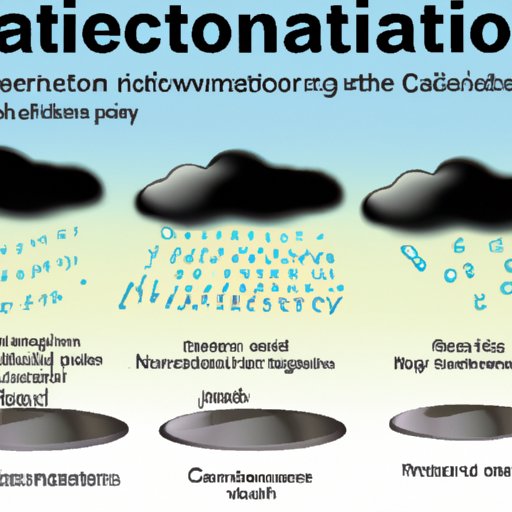Introduction
Precipitation is a form of water that falls from the atmosphere to the Earth’s surface. It includes rain, snow, sleet, hail, and other forms of frozen water. In this article, we will explore what does precipitation mean in science, looking at the science behind it, the different types and their characteristics, the effects on weather and climate, the measurements used, and the role of precipitation in the water cycle.
Explaining the Science Behind Precipitation
To understand precipitation, we must first define some terms. The atmosphere is the layer of air surrounding the Earth, consisting of several gases such as nitrogen, oxygen, and carbon dioxide. The atmosphere also contains water vapor, which is a form of water in a gaseous state. When the air becomes saturated with water vapor, condensation occurs, forming tiny droplets or crystals of liquid water or ice.
These droplets and crystals grow in size until they become heavy enough to fall from the atmosphere. This process is called precipitation. According to the National Weather Service, “Precipitation is any form of water that falls from the sky and reaches the ground.”
The causes of precipitation are complex and involve various environmental factors. Temperature, pressure, and humidity all play a role in determining whether precipitation will occur. Cold air can hold less moisture than warm air, so when cold air rises and mixes with warm air, condensation and precipitation can result. Low pressure systems also create instability in the atmosphere, leading to cloud formation and precipitation.
Precipitation can take many forms, including solid and liquid. Solid precipitation includes snow, hail, and sleet. Liquid precipitation includes rain and drizzle. Each type has its own characteristics and can affect weather and climate in different ways.
An Overview of Precipitation Types and Their Characteristics
Solid precipitation is composed of ice crystals or snowflakes that have grown large enough to fall from the atmosphere. Snow typically forms when temperatures are below freezing and the air is filled with tiny super-cooled water droplets. Hail is created by strong updrafts in thunderstorms, which carry droplets of water high into the atmosphere where they freeze into ice pellets. Sleet is a mix of rain and snow that forms when warm air melts snowflakes before they reach the ground.
Liquid precipitation is composed of small droplets of water that fall from clouds. Rain is the most common form of liquid precipitation and is created when air is saturated with water vapor and the temperature is above freezing. Drizzle is similar to rain but consists of smaller droplets that are more widely spaced.
The size and shape of precipitation particles can vary greatly, depending on the conditions in which they form. For example, snowflakes can range from simple six-sided crystals to intricate starbursts. The size of raindrops can range from 0.5 millimeters to 5 millimeters in diameter.

Examining How Precipitation Affects Weather and Climate
Precipitation can have a significant impact on both weather and climate. It can affect temperature, wind, and humidity. For instance, when rain falls, it cools the air, resulting in lower temperatures. Precipitation can also affect wind patterns, as moist air rises, creating an area of low pressure. This can lead to strong winds and storms.
Precipitation can also affect humidity levels. When rain falls, it adds moisture to the air, increasing the humidity. Conversely, when snow falls, it removes moisture from the air, decreasing the humidity. This is why snowfall often results in dry, cold weather.

Investigating How Precipitation is Measured
Precipitation measurements are an important part of meteorology and climate science. Scientists use various instruments to measure the amount and type of precipitation falling in a particular area. The most commonly used instruments are rain gauges, snow pillows, and radar.
Rain gauges are open containers that measure the amount of liquid precipitation falling in a given area. The data collected by rain gauges can be used to calculate total rainfall over a period of time. Snow pillows are surface-level devices that measure the amount of snow on the ground. Radar is used to detect precipitation in the atmosphere and estimate its intensity and location.

Analyzing the Role of Precipitation in the Water Cycle
Precipitation plays a vital role in the water cycle, which is the continuous movement of water between the atmosphere, land, and oceans. The process begins with evaporation, which is the conversion of liquid water into water vapor. The water vapor then rises into the atmosphere and condenses, forming clouds. When these clouds become saturated with water, precipitation occurs.
The precipitation then falls back to the Earth’s surface, where it can either evaporate, infiltrate the soil, or run off into streams and rivers. This runoff eventually flows back into the oceans, completing the cycle.
Conclusion
In this article, we explored what does precipitation mean in science. We looked at the science behind precipitation, the different types and their characteristics, the effects on weather and climate, the measurements used, and the role of precipitation in the water cycle. Precipitation is an essential part of the water cycle and has a major influence on our planet’s weather and climate.
From this article, we can see that precipitation is a complex and fascinating phenomenon that affects us all. By understanding how precipitation works and how it influences our environment, we can better prepare for and adapt to its effects.
To sum up, precipitation is a form of water that falls from the atmosphere to the Earth’s surface. It occurs when the air becomes saturated with water vapor and can take the form of rain, snow, sleet, hail, and other forms of frozen water. Precipitation has a significant impact on weather and climate and plays a crucial role in the water cycle.
(Note: Is this article not meeting your expectations? Do you have knowledge or insights to share? Unlock new opportunities and expand your reach by joining our authors team. Click Registration to join us and share your expertise with our readers.)
